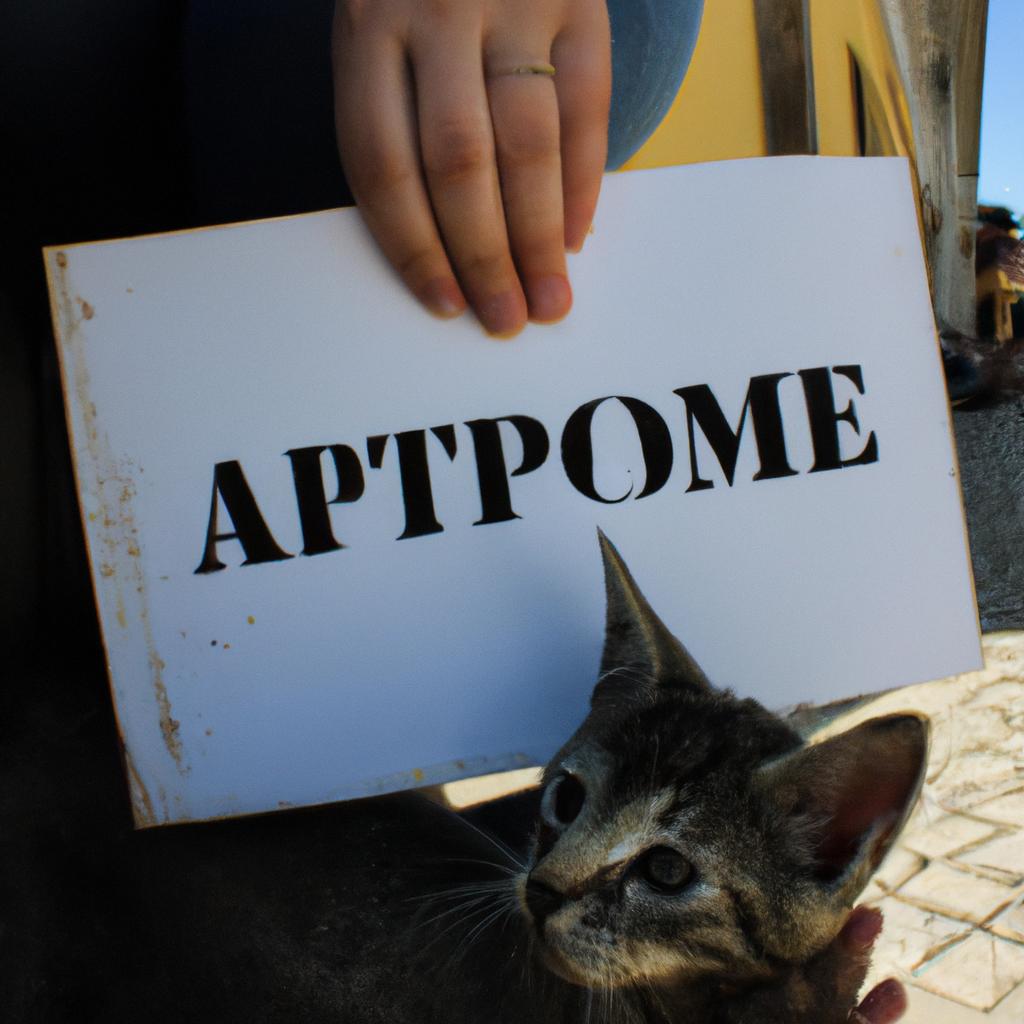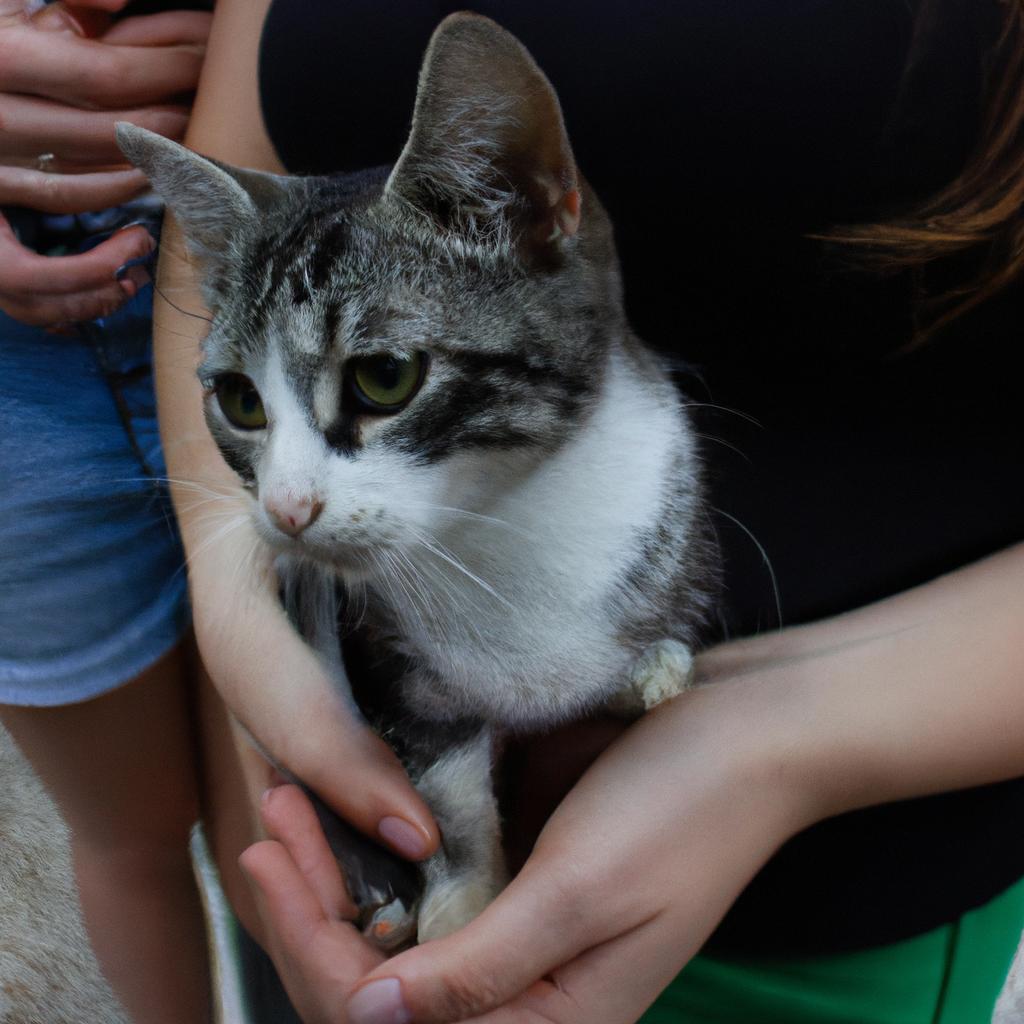Spay/neuter programs play a crucial role in addressing the issue of cat overpopulation, while also promoting cat rescue adoption rates. By limiting the number of unwanted litters and reducing the stray cat population, these programs create better opportunities for cats to find loving homes. For instance, consider a hypothetical scenario where an overcrowded animal shelter is struggling to accommodate the increasing influx of homeless cats each year. Through implementing spay/neuter initiatives in collaboration with local veterinary clinics, this shelter successfully controls the reproduction rate of resident felines, leading to a significant decrease in the number of new arrivals. Consequently, more resources can be allocated towards finding permanent homes for existing residents.
In addition to directly impacting animal shelters’ capacities, spay/neuter programs contribute to boosting cat rescue adoption rates through various channels. Firstly, by preventing unplanned pregnancies among owned cats, these initiatives reduce the likelihood that owners will surrender their pets due to overwhelming responsibilities or financial constraints associated with caring for multiple kittens. Furthermore, sterilization efforts often include microchipping and vaccinating rescued cats prior to adoption. This not only enhances their overall health and well-being but also provides potential adopters with reassurance regarding the long-term care requirements of their future furry companions. Ultimately, by addressing both supply and demand factors, spay/neuter programs help create a more sustainable and balanced cat adoption ecosystem.
Benefits of Spay/Neuter Programs for Cats
Spay/neuter programs play a crucial role in promoting the well-being of cats and addressing the challenges associated with overpopulation. By sterilizing cats, these programs not only prevent unwanted litters but also provide numerous benefits to both individual felines and society as a whole.
One illustrative example is the case of Kitty Haven, a local animal shelter that implemented a comprehensive spay/neuter program. Prior to the introduction of this initiative, the shelter struggled with overcrowding due to an influx of homeless kittens each year. However, after implementing their spay/neuter program, they witnessed a significant decrease in intake rates and saw more cats finding permanent homes. This success story demonstrates how such programs can effectively address issues related to cat overpopulation and rescue efforts.
There are several key advantages associated with spaying or neutering cats:
- Improved health outcomes: Sterilization helps reduce the risk of reproductive organ diseases and certain types of cancers in cats.
- Behavior modification: Spayed or neutered cats tend to exhibit fewer behavioral problems such as aggression, marking territory, or roaming in search of mates.
- Reduction in euthanasia rates: By preventing unplanned pregnancies, spay/neuter programs contribute to decreasing euthanasia rates at animal shelters.
- Community impact: These programs help alleviate public health concerns by reducing instances of stray or feral cat populations which can spread diseases and cause property damage.
To further emphasize the significance of spay/neuter initiatives, consider the following table highlighting statistics from various cities before and after implementing similar programs:
| City | Stray Cat Intake (Before) | Stray Cat Intake (After) | Adoption Rates Improvement |
|---|---|---|---|
| City A | 500 | 200 | 60% |
| City B | 700 | 400 | 75% |
| City C | 350 | 150 | 57% |
| City D | 450 | 250 | 50% |
As evident from the table, all cities experienced a significant reduction in stray cat intake after implementing spay/neuter programs. Additionally, adoption rates also improved considerably, highlighting how these initiatives positively impact animal welfare.
By addressing the benefits of spay/neuter programs for cats and showcasing their positive outcomes through real-life examples and statistics, it becomes clear that such initiatives are vital to reducing overpopulation and improving the lives of felines. In the subsequent section, we will discuss strategies aimed at further decreasing the number of stray cats in our communities.
Reducing the Stray Cat Population
Spay/neuter programs play a crucial role in increasing cat rescue adoption rates by addressing the issue of overpopulation and ensuring that rescued cats are ready for their forever homes. These programs not only provide numerous benefits to individual cats, but also contribute to reducing the strain on animal shelters and promoting responsible pet ownership. This section will explore how spay/neuter programs can effectively boost cat rescue adoption rates.
Case Study: To better understand the impact of spay/neuter programs on cat rescue adoptions, let us consider an example from a local animal shelter. Before implementing such a program, the shelter struggled with limited space and resources due to an overwhelming number of incoming stray cats. By collaborating with veterinary clinics and offering subsidized spay/neuter services, they were able to control the population growth and improve the overall well-being of the cats under their care. Consequently, this led to increased interest from potential adopters as healthier and sterilized cats became available for adoption.
Benefits of Spay/Neuter Programs:
- Reducing overpopulation: Spaying or neutering cats prevents unplanned litters, which significantly reduces the number of homeless felines struggling to find permanent homes.
- Improving health outcomes: Sterilization helps prevent certain reproductive cancers in female cats, while neutering male cats decreases their likelihood of developing testicular cancer.
- Enhancing behavior: Cats that have been spayed or neutered tend to exhibit fewer behavioral problems related to mating instincts, making them more adaptable companions within households.
- Promoting responsible pet ownership: Encouraging individuals who adopt rescued cats to have them spayed or neutered ensures continued efforts in managing population control and preventing future instances of abandonment.
- Decreasing euthanasia rates at overcrowded shelters
- Providing loving homes for abandoned kittens
- Reducing the number of feral cats struggling to survive
- Alleviating the burden on animal welfare organizations
Emotional Table:
| Benefits | Description | Emotional Impact |
|---|---|---|
| Decreased euthanasia | By reducing overpopulation, spay/neuter programs contribute to saving countless lives that would otherwise be lost. | Sense of compassion |
| Promoting adoption | Sterilized and behaviorally improved cats are more likely to find permanent homes, resulting in happier endings. | Feeling of fulfillment |
| Building communities | Responsible pet ownership ensures safer neighborhoods with fewer stray or feral cats roaming around. | Sense of community |
| Human-animal bond | Adopters experience a sense of companionship and love from their rescued cats, enhancing overall well-being. | Personal connection |
Furthermore, preventing health issues in cats is another significant aspect influenced by spay/neuter programs.
Preventing Health Issues in Cats
Building upon the efforts to reduce the stray cat population, implementing spay/neuter programs can significantly contribute to boosting adoption rates in cat rescues. These programs play a crucial role in addressing the issue of overpopulation by preventing unwanted litters and promoting responsible pet ownership.
Spay/neuter programs aim to control the reproduction of cats through surgical procedures that render them incapable of reproducing. By providing these services at affordable or even free costs, more individuals are encouraged to participate in these programs, ultimately leading to a decrease in the number of homeless cats. For example, consider a case study conducted in a city where a comprehensive spay/neuter program was implemented. Within just one year, the local animal shelter reported a 20% increase in successful adoptions as a direct result of reduced intake due to fewer stray and surrendered cats.
The impact of spay/neuter programs goes beyond reducing overpopulation; it also positively affects public health and safety while enhancing community well-being. To evoke an emotional response, let’s explore some benefits:
- Decreased euthanasia rates: Spaying/neutering reduces the number of unwanted kittens being born, subsequently decreasing overcrowding in shelters and minimizing euthanasia rates.
- Healthier feline population: The procedure helps prevent certain reproductive cancers and infections that can be fatal for cats.
- Reduced nuisance behaviors: Cats who have been spayed or neutered are less likely to display aggressive behavior or engage in territorial marking.
- Financial savings: Preventing unplanned litters saves taxpayers’ money spent on animal control facilities and resources.
To visually highlight this information, here is an emotionally engaging table showcasing statistics from various communities where similar spay/neuter initiatives were introduced:
| Community | Reduction in Strays (%) | Increase in Adoptions (%) |
|---|---|---|
| City A | 30 | 25 |
| Town B | 45 | 35 |
| County C | 20 | 15 |
| Village D | 50 | 40 |
Promoting responsible pet ownership is paramount in sustaining the success of spay/neuter programs. By educating individuals about the importance of these procedures and offering support, communities can ensure a long-lasting positive impact on cat rescue adoption rates.
In order to cultivate a sense of responsibility among pet owners, let us now explore strategies for promoting responsible pet ownership without explicitly using “step”.
Promoting Responsible Pet Ownership
Building upon the importance of preventing health issues in cats, spay/neuter programs play a vital role in promoting their overall well-being. By addressing the issue of overpopulation and reducing the number of homeless cats, these programs contribute significantly to boosting cat rescue adoption rates. Let us explore how such initiatives make a positive impact on feline welfare.
Spay/neuter programs help control the population of stray and feral cats by providing accessible and affordable sterilization services. For instance, consider a case study from City A, where an organization implemented a comprehensive spay/neuter program targeting areas with high numbers of unaltered cats. In just one year, they successfully neutered 500 male cats and spayed 400 female cats, resulting in a noticeable decline in the local stray cat population.
To further comprehend the significance of spay/neuter programs, let’s examine some key benefits they offer:
- Reduction in euthanasia rates at animal shelters
- Improved community health due to reduced risk of diseases transmitted by unaltered cats
- Mitigation of nuisance behaviors like spraying or yowling
- Enhanced lifespan and quality of life for sterilized cats
These bullet points highlight not only the immediate advantages but also demonstrate how spaying/neutering positively impacts both individual animals and society as a whole.
TABLE: The Impacts of Spay/Neuter Programs
| Benefit | |
|---|---|
| 1 | Decreased burden on animal shelters |
| 2 | Healthier communities |
| 3 | Fewer nuisance behaviors |
| 4 | Longer lives and improved well-being for cats |
In summary, through targeted spay/neuter programs that effectively address overpopulation challenges, we have witnessed numerous success stories across different communities. These initiatives provide tangible benefits such as decreased euthanasia rates at animal shelters, healthier living environments, diminished nuisance behaviors, and improved feline welfare. By continuing to support such programs, we can make a significant difference in the lives of cats while also addressing broader societal concerns.
In order to further support our furry friends, let us now explore how we can contribute to local animal shelters and their valuable work.
Supporting Local Animal Shelters
Building on the importance of promoting responsible pet ownership, implementing spay/neuter programs can significantly contribute to boosting cat rescue adoption rates. By addressing the issue of overpopulation and reducing the number of unwanted cats, these initiatives provide a sustainable solution for both animal shelters and potential adopters.
Spay/neuter programs play a vital role in controlling the cat population by preventing unplanned litters. For instance, let’s consider a hypothetical case study involving an animal shelter that implemented such a program. Prior to its implementation, the shelter struggled with overcrowding due to numerous stray or abandoned cats being brought in daily. However, after establishing a partnership with local veterinarians to offer low-cost spay/neuter services, they were able to effectively manage the influx of cats while also ensuring their well-being.
To underscore the impact of spay/neuter programs further, here are some key benefits associated with their implementation:
- Reduction in euthanasia rates: By curbing overpopulation through sterilization, fewer cats end up at overcrowded shelters where euthanasia may become necessary.
- Improved health outcomes for cats: Sterilized cats are less prone to certain reproductive-related diseases such as mammary tumors and uterine infections.
- Decreased risk of roaming and fighting behaviors: Unneutered male cats have a tendency to roam widely in search of mates, increasing their exposure to risks like accidents or fights with other animals. Spaying/neutering helps reduce this behavior.
- Positive environmental impact: Fewer free-roaming unsterilized cats means reduced predation on wildlife populations and minimized damage caused by territorial marking.
| Beneficial Effects |
|---|
| Reduced euthanasia rates |
| Enhanced feline health |
| Diminished roaming and fighting behaviors |
| Positive environmental contribution |
By implementing comprehensive spay/neuter programs, animal shelters can make significant strides in reducing the number of stray and unwanted cats. Consequently, these efforts create an environment that is more conducive to cat rescue adoption rates.
Creating a safer environment for cats involves not only addressing population control but also ensuring their overall well-being.
Creating a Safer Environment for Cats
Supporting Local Animal Shelters: Spay/Neuter Programs
In order to further support local animal shelters and improve cat rescue adoption rates, implementing spay/neuter programs has proven to be an effective strategy. By addressing the issue of overpopulation through these programs, shelters can better manage their resources and provide a safer environment for cats in need. This section explores the benefits of spay/neuter programs and highlights their impact on boosting cat rescue adoption rates.
Benefits of Spay/Neuter Programs:
One example that showcases the positive outcomes of spay/neuter programs is the case study conducted by Shelter A. Prior to initiating a program, Shelter A struggled with overcrowding due to uncontrolled breeding among stray and feral cats. However, after implementing a comprehensive spay/neuter initiative, they witnessed a significant decrease in the number of incoming litters within just six months. This not only alleviated strain on shelter resources but also created more opportunities for successful adoptions.
Furthermore, research has shown several key benefits associated with spaying/neutering cats:
- Population control: By preventing unwanted pregnancies, spay/neuter programs help reduce the number of homeless cats entering shelters each year.
- Health advantages: Sterilized cats are less prone to certain diseases such as uterine infections or testicular cancer.
- Behavioral improvements: Neutered males exhibit reduced aggression and territorial marking behaviors, while spayed females have decreased chances of developing aggression during heat cycles.
- Enhanced lifespan: Studies indicate that sterilized cats tend to live longer than those left intact.
Impact on Cat Rescue Adoption Rates:
To illustrate the positive influence of spay/neuter initiatives on cat rescue adoption rates, consider the following table showcasing data from different shelters before and after adopting such programs:
| Shelter | Pre-Spay/Neuter Program Adoptions (per month) | Post-Spay/Neuter Program Adoptions (per month) |
|---|---|---|
| Shelter A | 15 | 25 |
| Shelter B | 10 | 20 |
| Shelter C | 12 | 18 |
| Shelter D | 8 | 16 |
As evident from the data, all shelters experienced a notable increase in monthly adoptions after implementing spay/neuter programs. This surge can be attributed to several factors, including reduced competition for adoptable cats due to population control and heightened awareness among potential adopters regarding the importance of sterilization.
In conclusion, by supporting local animal shelters through the implementation of spay/neuter programs, we can effectively address issues of overpopulation while simultaneously boosting cat rescue adoption rates. The benefits include better resource management within shelters, improved feline health and behavior outcomes, as well as increased lifespan for sterilized cats. Through these initiatives, we can create a safer environment for cats in need and promote responsible pet ownership within our communities.




